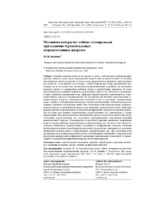| dc.contributor.author | Бладыко, Ю. В. | |
| dc.coverage.spatial | Минск | ru |
| dc.date.accessioned | 2020-12-02T08:01:43Z | |
| dc.date.available | 2020-12-02T08:01:43Z | |
| dc.date.issued | 2020 | |
| dc.identifier.citation | Бладыко, Ю. В. Механический расчет гибких токопроводов при наличии горизонтальных сосредоточенных нагрузок = Mechanical Calculation of Flexible Wires in the Presence of Horizontal Concentrated Loads / Ю. В. Бладыко // Энергетика. Известия высших учебных заведений и энергетических объединений СНГ. – 2020. – № 6. – С. 500-514. | ru |
| dc.identifier.uri | https://rep.bntu.by/handle/data/82055 | |
| dc.description.abstract | Погонная ветровая нагрузка на провода и тросы, действующая перпендикулярно проводу, зависит от угла между направлением ветра и осью воздушной линии. В методике механического расчета проводов и тросов ветер рекомендуется принимать направленным под углом 90° к оси пролета и не сказано, с какой стороны дует ветер. Для пролетов воздушных это не так важно, как для пролетов распределительных устройств, где отклонения проводов зависят от направления действия отпаек к электрическим аппаратам. В статье рассматриваются различные варианты расположения отпаек и их действие на токопровод, а также изменение направления ветра. Приведен алгоритм расчета горизонтального отклонения гибкого провода и коэффициентов его увеличения при наличии горизонтальных сосредоточенных нагрузок, обусловленных действием ветра на распорки, заградительные шары, отпайки к электрическим аппаратам и другие конструктивные элементы распределительных устройств и воздушных линий. При отсутствии ветра горизонтальные сосредоточенные нагрузки и отклонения возникают при некилевом расположении отпаек. Выведены формулы расчета горизонтальной составляющей коэффициента нагрузки для решения уравнения состояния при наличии горизонтальных сосредоточенных сил, действующих в любых направлениях. Получены результаты механического расчета для случаев одной и двух горизонтальных сосредоточенных сил, по-разному ориентированных относительно ветровой распределенной нагрузки. Рекомендуется в проектной практике принимать направление ветра в сторону действия горизонтальных сосредоточенных сил, так как в этом случае получаются наибольшие горизонтальные отклонения и коэффициенты нагрузки. Снижение коэффициентов горизонтальной нагрузки происходит при разгрузке токопровода от встречных направлений действия ветра и горизонтальных сосредоточенных сил. При отсутствии ветра предлагается пользоваться формулами расчета горизонтальных отклонений и нагрузки после нахождения произведений коэффициента увеличения горизонтальных отклонений и горизонтальной составляющей коэффициента нагрузки на погонную нагрузку. | ru |
| dc.language.iso | ru | ru |
| dc.publisher | БНТУ | ru |
| dc.title | Механический расчет гибких токопроводов при наличии горизонтальных сосредоточенных нагрузок | ru |
| dc.title.alternative | Mechanical Calculation of Flexible Wires in the Presence of Horizontal Concentrated Loads | ru |
| dc.type | Article | ru |
| dc.identifier.doi | 10.21122/1029-7448-2020-63-6-500-514 | |
| local.description.annotation | The linear wind load on the wires and cables acting perpendicular to the wire depends on the angle between the direction of the wind and the axis of the overhead line. In the methodology of mechanical calculation of wires and cables, it is recommended to take the wind directed at an angle of 90° to the axis of span and it is not specified which side the wind blows from. For spans of air, this is not so much significant as for switchgear spans, where the deviations of the wires depend on the direction of action of the taps to the electrical apparatus. The article discusses various options for the location of taps and their effect on the wire, as well as changing the direction of the wind. An algorithm for calculating the horizontal deviation of a flexible wire and its increase coefficients in the presence of horizontal concentrated loads due to the action of wind on spacers, barriers, taps to electrical apparatuses and other structural elements of substations and overhead lines is given. In the absence of wind, horizontal concentrated loads and deviations occur when an arrangement of the taps is non-keel. The formulas for calculating the horizontal component of the load coefficient to solve the equation of state in the presence of horizontal concentrated forces acting in any direction have been derived. The results of the mechanical calculation are obtained for the cases of one and two horizontal concentrated forces, differently oriented with respect to the distributed wind load. In design practice it is recommended to take the wind flow in the direction of the action of horizontal concentrated forces, since in this case the greatest horizontal deviations and load factors are obtained. The reduction in the coefficients of the horizontal load occurs when the current lead is unloaded because of the opposite directions of the wind and horizontal concentrated forces. In the absence of wind, it is proposed to use the formulas for calculating horizontal deviations and load after finding the product of the coefficient of increase in horizontal deviations and the horizontal component of the coefficient of load per linear load. | ru |

